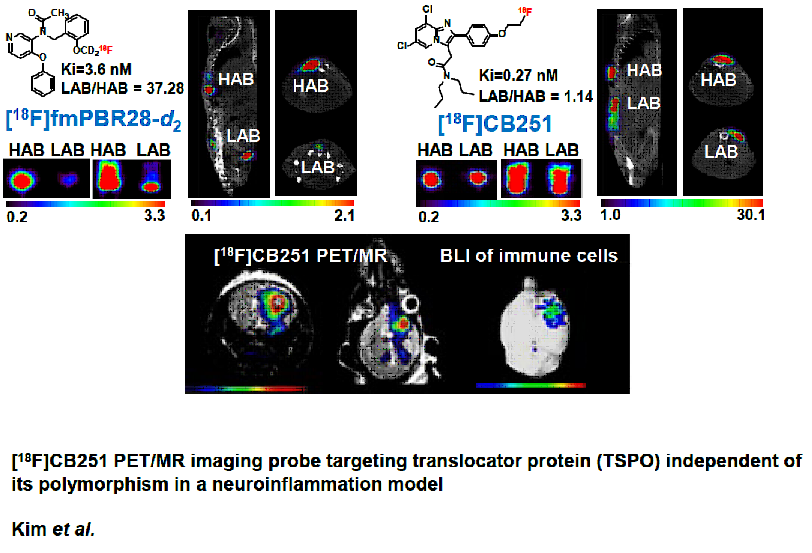글로벌 연구동향
분자영상 및 방사화학
- [Theranostics.] [ 18 F]CB251 PET/MR imaging probe targeting translocator protein (TSPO) independent of its Polymorphism in a Neuroinflammation Model
서울대 / 김경민, 윤혜원*, 이병철*
- 출처
- Theranostics.
- 등재일
- 2020 Jul 23
- 저널이슈번호
- 10(20):9315-9331. doi: 10.7150/thno.46875. eCollection 2020.
- 내용
Abstract
The 18 kDa translocator protein (TSPO) has been proposed as a biomarker for the detection of neuroinflammation. Although various PET probes targeting TSPO have been developed, a highly selective probe for detecting TSPO is still needed because single nucleotide polymorphisms in the human TSPO gene greatly affect the binding affinity of TSPO ligands. Here, we describe the visualization of neuroinflammation with a multimodality imaging system using our recently developed TSPO-targeting radionuclide PET probe [18F]CB251, which is less affected by TSPO polymorphisms. Methods: To test the selectivity of [18F]CB251 for TSPO polymorphisms, 293FT cells expressing polymorphic TSPO were generated by introducing the coding sequences of wild-type (WT) and mutant (Alanine → Threonine at 147th Amino Acid; A147T) forms. Competitive inhibition assay was conducted with [3H]PK11195 and various TSPO ligands using membrane proteins isolated from 293FT cells expressing TSPO WT or mutant-A147T, representing high-affinity binder (HAB) or low-affinity binder (LAB), respectively. IC50 values of each ligand to [3H]PK11195 in HAB or LAB were measured and the ratio of IC50 values of each ligand to [3H]PK11195 in HAB to LAB was calculated, indicating the sensitivity of TSPO polymorphism. Cellular uptake of [18F]CB251 was measured with different TSPO polymorphisms, and phantom studies of [18F]CB251-PET using 293FT cells were performed. To test TSPO-specific cellular uptake of [18F]CB251, TSPO expression was regulated with pCMV-TSPO (or shTSPO)/eGFP vector. Intracranial lipopolysaccharide (LPS) treatment was used to induce regional inflammation in the mouse brain. Gadolinium (Gd)-DOTA MRI was used to monitor the disruption of the blood-brain barrier (BBB) and infiltration by immune cells. Infiltration of peripheral immune cells across the BBB, which exacerbates neuroinflammation to produce higher levels of neurotoxicity, was also monitored with bioluminescence imaging (BLI). Peripheral immune cells isolated from luciferase-expressing transgenic mice were transferred to syngeneic inflamed mice. Neuroinflammation was monitored with [18F]CB251-PET/MR and BLI. To evaluate the effects of anti-inflammatory agents on intracranial inflammation, an inflammatory cytokine inhibitor, 2-cyano-3, 12-dioxooleana-1, 9-dien-28-oic acid methyl ester (CDDO-Me) was administered in intracranial LPS challenged mice. Results: The ratio of IC50 values of [18F]CB251 in HAB to LAB indicated similar binding affinity to WT and mutant TSPO and was less affected by TSPO polymorphisms. [18F]CB251 was specific for TSPO, and its cellular uptake reflected the amount of TSPO. Higher [18F]CB251 uptake was also observed in activated immune cells. Simultaneous [18F]CB251-PET/MRI showed that [18F]CB251 radioactivity was co-registered with the MR signals in the same region of the brain of LPS-injected mice. Luciferase-expressing peripheral immune cells were located at the site of LPS-injected right striatum. Quantitative evaluation of the anti-inflammatory effect of CDDO-Me on neuroinflammation was successfully monitored with TSPO-targeting [18F]CB251-PET/MR and BLI. Conclusion: Our results indicate that [18F]CB251-PET has great potential for detecting neuroinflammation with higher TSPO selectivity regardless of polymorphisms. Our multimodal imaging system, [18F]CB251-PET/MRI, tested for evaluating the efficacy of anti-inflammatory agents in preclinical studies, might be an effective method to assess the severity and therapeutic response of neuroinflammation.
Affiliations
Kyungmin Kim 1 2 3 , Ha Kim 1 3 , Sung-Hwan Bae 1 3 , Seok-Yong Lee 1 2 3 , Young-Hwa Kim 1 3 4 , Juri Na 1 2 3 , Chul-Hee Lee 1 2 3 , Min Sun Lee 1 , Guen Bae Ko 1 5 , Kyeong Yun Kim 1 5 , Sang-Hee Lee 6 4 , In Ho Song 6 , Gi Jeong Cheon 1 3 , Keon Wook Kang 1 2 3 , Sang Eun Kim 6 4 7 , June-Key Chung 1 8 , Euishin Edmund Kim 1 , Sun-Ha Paek 2 9 , Jae Sung Lee 1 2 5 , Byung Chul Lee 6 7 , Hyewon Youn 1 3
1 Department of Nuclear Medicine, Seoul National University Hospital, Republic of Korea.
2 Biomedical Sciences, Cancer Research Institute, Seoul National University College of Medicine, Republic of Korea.
3 Laboratory of Molecular Imaging and Therapy, Cancer Research Institute, Seoul National University College of Medicine, Republic of Korea.
4 Department of Transdisciplinary Studies, Graduate School of Convergence Science and Technology, Seoul National University, Republic of Korea.
5 Brightonix Imaging Inc., National Cancer Institute, Republic of Korea.
6 Department of Nuclear Medicine, Seoul National University Bundang Hospital, Republic of Korea.
7 Center for Nanomolecular Imaging and Innovative Drug Development, Advanced Institutes of Convergence Technology, Seoul National University, Republic of Korea.
8 Department of Nuclear Medicine, National Cancer Institute, Republic of Korea.
9 Department of Neurosurgery, Seoul National University Hospital, Republic of Korea.
- 키워드
- PET/MRI; TSPO; multimodal imaging; neuroinflammation; polymorphism.
- 연구소개
- 신경염증 PET영상을 위한 TSPO를 표적하는 다양한 프로브 (PK11195, PBR28, GE-180 등) 개발이 이어져 왔으나, 이제까지 개발되어 온 프로브들은 인간에서 발견되는 TSPO 다형성 (polymorphic) 단백질 (HAB, high affinity binding; LAB, low affinity binding, 백인의 경우 약 30%가 LAB 발현)에 대한 결합 차이를 보여 임상 적용에 어려움이 있었음. 본 연구에서는 TSPO에 특이적인 프로브 CB251을 이용하여, TSPO 다형성 단백질에 대한 결합에는 차이가 거의 없음을 보이고, 이를 이용한 신경염증 진단영상 및 치료효과 평가를 위한 프로브로 이용 가능성을 다중영상분석 (PET/MR, BLI) 을 통해 제시하였음. 본 연구는 Theranostics 2020년 10월 표지로 선정되었음.
- 덧글달기










편집위원
이 논문은 이 그룹에서 최근 개발한 방사성의약품인 [18F]CB251를이용하여 신경염증(neuroinflammation) 영상화를 위한 바이오마커인 TSPO(18 kDa translocator protein)를 표적으로 하는 동물의 PET/MRI 및 BLI 등 다중 분자영상 결과를 보여주며, 효과적인 신경염증 치료 모니터링 가능성을 제시하고 있다.
2020-10-06 09:30:40